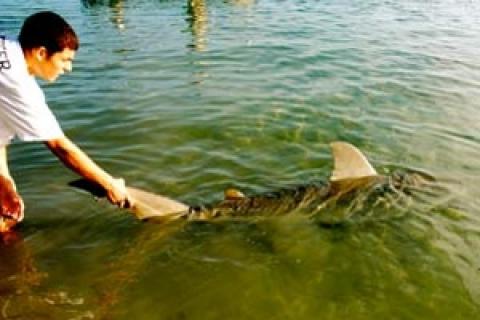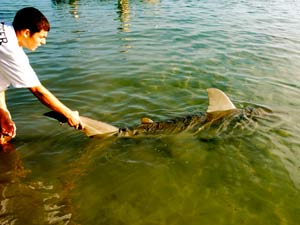
When I began my customary pre-article research, I'd thought my sharking knowledge was pretty thorough from years of fishing them on the flats. But my ensuing investigative work of beach shark fishing uncovered an unexpectedly evolved and fascinating world. It is an intact marvelous subculture that has a rich mix of solid history, plenty of heroes, dedicated membership and a very evolved methodology. It's a striking world where the angling goes on day or night with well-laid plans for not just battle, but release as well.
 |
| Beach shark fishing opens up whole new challenges. |
Solid, Noble Foundation
Fishing for sharks off the beach exudes the concept of sport fishing right down into its marrow. This specialty is founded on the commitment to unassisted fishing. There is no moving vessel to help you chase down your adversary. You have no boat to back down on your shark or plane it up. There is no captain on a flying bridge looking down to shout out strategic instructions. And there is no mate to swing your fighting chair into an optimized fighting angle. It's simply an angler "stuck" on a single spot, fighting a huge adversary that might be hundreds of yards away!
Victory can only come by fighting that distant giant all the way back to the rod tip into ankle-deep water. The beach-sharker must have the tackle capable of achieving such a seemingly impossible task. The three basic requirements — which will be discussed in more detail later — are massive line capacity, smooth (reel) drag operation, and rods having the beef to be Conan-strong in battle. All of this strikes one as simply epic, much like Hemingway's Santiago and his handline-fought marlin.
Some giant shark anglers challenge themselves being stationary from a bridge. But, to me, going after sharks from the beach seems more exciting and challenging than pursuing them from stationary elevations like bridges. In addition, since you're literally even with your quarry on the waterline, you have the intimacy of a battle that only kayak fishermen or waders would really appreciate.
What and Where
The U.S. has sandy beaches that stretch from New England to Texas (and parts of California) and therefore offers a huge swath of beach sharking opportunities. This coast offers varied actual shoreline features that are less favorable, such as rocky New England shores, marshy reeded zones in parts of South Carolina, Georgia, and Louisiana, and finally slow drop-off mud, sand, and rock flats like in the Florida Keys and certain parts of the Texas coast. As long as an angler can find sand beaches fronting the ocean and quickly sloping into deeper water, they should be fine. Surfers often favor these waters, which not surprisingly accounts for so many surfer/shark encounters.
There are so many species of sharks to be caught from beaches and at the barest minimum, can include bulls, blacktips, lemons, spinners, nurses, tigers, sandbars and hammerheads. What these and other beach-fished sharks require are three factors to be present and in a feeding mood. First, there must be enough water column and depth to house a large shark. Second, the water temperature must be high enough for the shark to start feeding. This often begins in the mid-70s and has no real upper end — sharks feed quite well in very warm water. Lastly, there must be an environment that favors baitfish and game fish activity, like an ocean inlet. Incidentally, sharks utilize these passes as highways from ocean to bay and back.
Game Plan
One of Florida's foremost beach sharkers is Colby Uva of Miami. He has developed a methodology that serves as a strong template for newcomers and experienced big shark anglers alike. Though he shark fished as a boy, the last five of his 20 years have become exponentially "sharkified" as he steeped himself in the study and methodology of taking sharks as big as 300-400 pounds from the beach.
When I interviewed Uva, it became clear that there were three phases of beach sharking: the planning/bait placement/tackle setup phase, the battle segment and finally, the release.
Shark Fishing Tackle
As discussed earlier, big battles mean big weapons. Reels that consistently do the job are conventional star drag models that have huge line capacity. The Penn Senator series are popular with anglers like Uva. Some of these reels are so big they look like sideways buckets! The line on the reel can be 100-pound test. Some choose braid and some chose monofilament. While the well-known debate between the two still lingers, it is beyond the scope of this article to discuss this in depth. It bears repeating that one can pack more braid on reels than mono because of the former's lower diameter/per pound test. In addition, anglers can put more unrelenting pressure on the shark with braid because of its lower stretch. On the other hand, braid tends to "bury on itself" on conventional spools, needs hand-tightened retrieves, is hard to cut and make knots with, and can be dangerous if it wraps around any body part in battle, as can mono.
The rods, of course, must have the strength, diameters, blank walls and material construction to handle extreme pressures without shattering and exploding. Those qualities might have it looking at a minimum like the pool cues that Fast Eddie Felson dispatched his opponents with. The guides and reel seat must be of the best quality.
The balance of the tackle is the terminal portion. The basic practice is to use a very long shock leader of 400-pound mono affixed by ball bearing swivels or snap swivels. This first portion should at least be 15 feet to account for brushes with the shark's rough body. Anglers then add the final leader of No. 19 wire, which can be as long as 10 feet or more. Finally, a hook or hooks from 10/0 to 16/0 are added. It is best to use crimp fasteners over knots and wire "twists" whenever possible.
Shark Baits / Rigging
There is some consensus that highly scented and/or very bloody fish such a barracuda, amberjack or bonito seem ideal as shark bait. It may also be important to vary one's bait choice based on the locale, the prey species currently active as well as the time of year.
It is common for sharkers to need two hooks — as large as 12/0 and tethered together by No. 19 wire — to effectively cover a bait that may be as large as 50 pounds. Check specific state regulations as to the number of hooks that may be used for sharking in that jurisdiction.
The exact number and placement of the hooks can be determined by the size and species of the shark as well as the kind of bait. In addition, hook placement means a great deal with sharks that may first mouth a bait, turn it around, and then engulf it. Oftentimes, the line runoff rate during "the take" may show the aggression of the strike, and hence, when to lift the rod to sink the hooks. Always try to effectuate a perpendicular relationship between the hook shank and the countoured slab sides of the bait. If the hooks lay flush on their sides against the bait, the final strike-to-hookup ratio will obviously be quite poor.
Bait Placement
Although sharks are sometimes found right in the "wash" of some deep-drop beaches, customarily placing the bait a few hundred yards off shore will bring more strikes. Since these huge outfits are not casting tools, the most realistic way to do this is by kayak. Once the bait is dropped off the vessel to the bottom, pre-rigged specialized sinkers or rocks on breakaway lines should keep the bait in place. This is especially important in high-current areas like inlets and passes.
The Battle
Since this exciting specialty is not for the faint of heart, it must be clear that the angler must have a good level of physical fitness. Battling a huge game fish possibly hundreds of yards away for hours entails enormous muscular strength challenge. The upper body is involved with the rod and reel and the legs are supporting this entire effort. The battle itself consists of mightily pulling and reeling against huge drag pressures as well as running up and down the beach at times to stay even with the quarry. It is good for the beach sharker to have a sensible knowledge of body mechanics in an enterprise where muscular fatigue and failure remain an ongoing risk.
The Release
This part of the process demands heavy gloves, a friend, a first-aid kit, possibly a rope, ankle-deep water and the most extreme commitment to safety and caution. Either you or your friend holds the rod while the other attempts to "tail" the shark and drag it into wet sand for measurement, some photographs and a quick release back into the surf. Not surprisingly, this is the most serious part of the process where the goal is to have both angler and fish remain intact and healthy when the battle is done.
It bears mention that Uva and others like him advocate catch and release fishing for sharks. Hopefully this trend will influence anyone that still kills sharks to give up their mistaken ways.
- 41279 views

